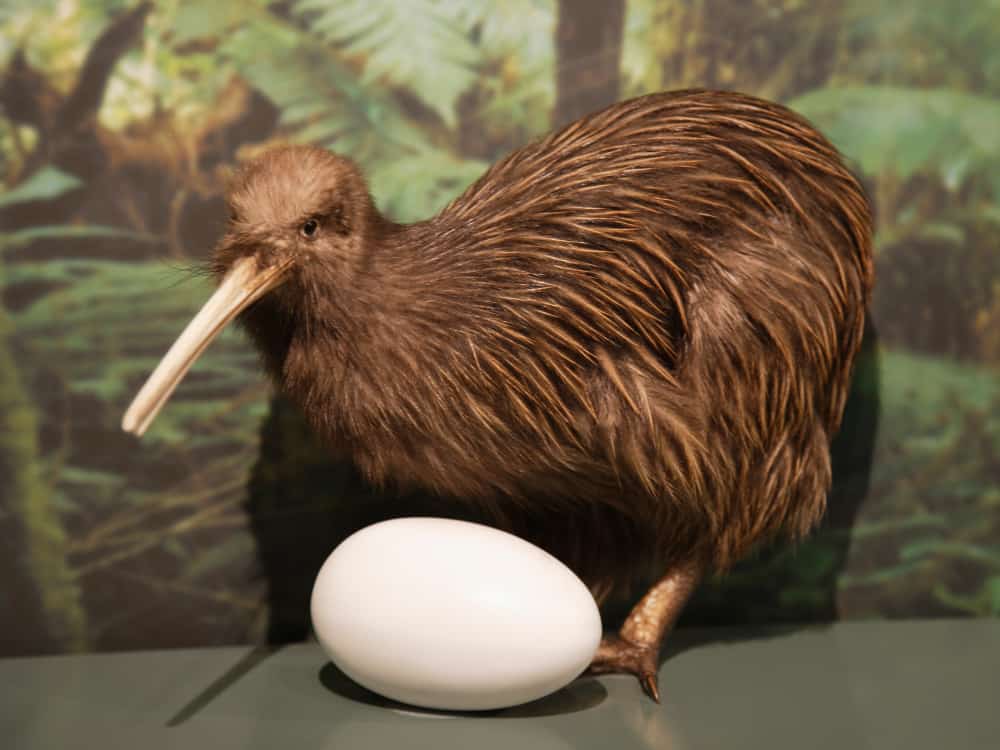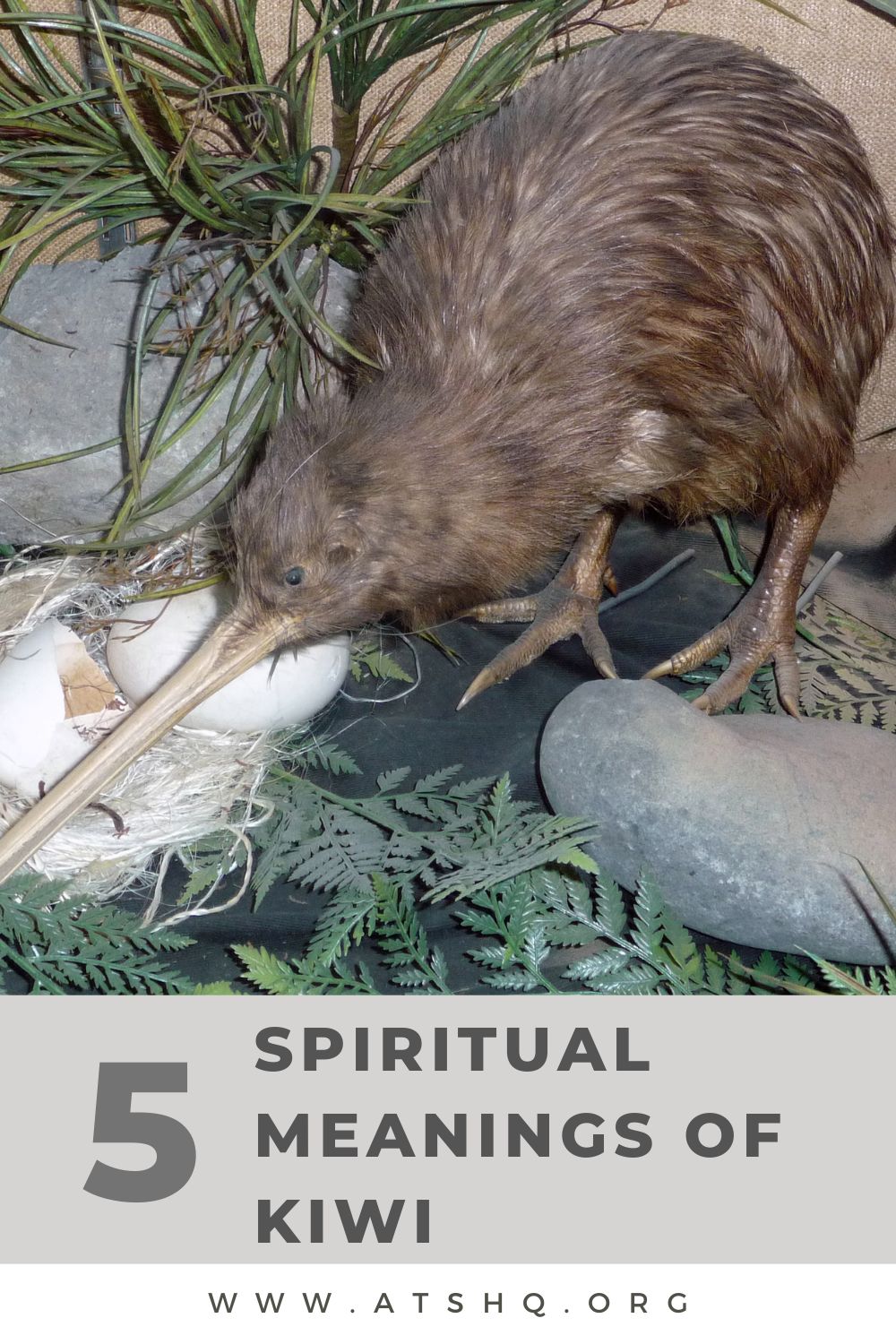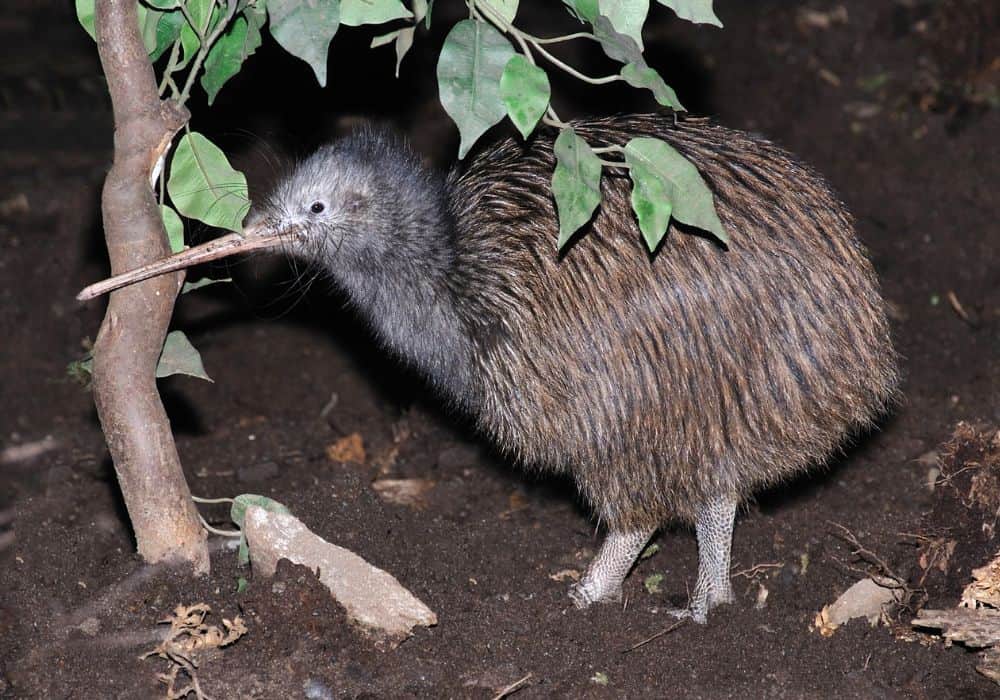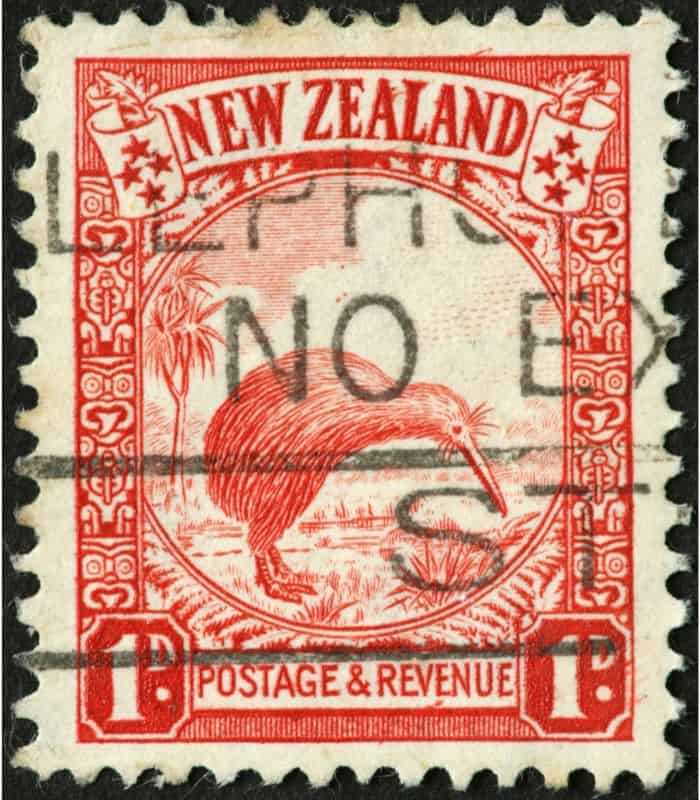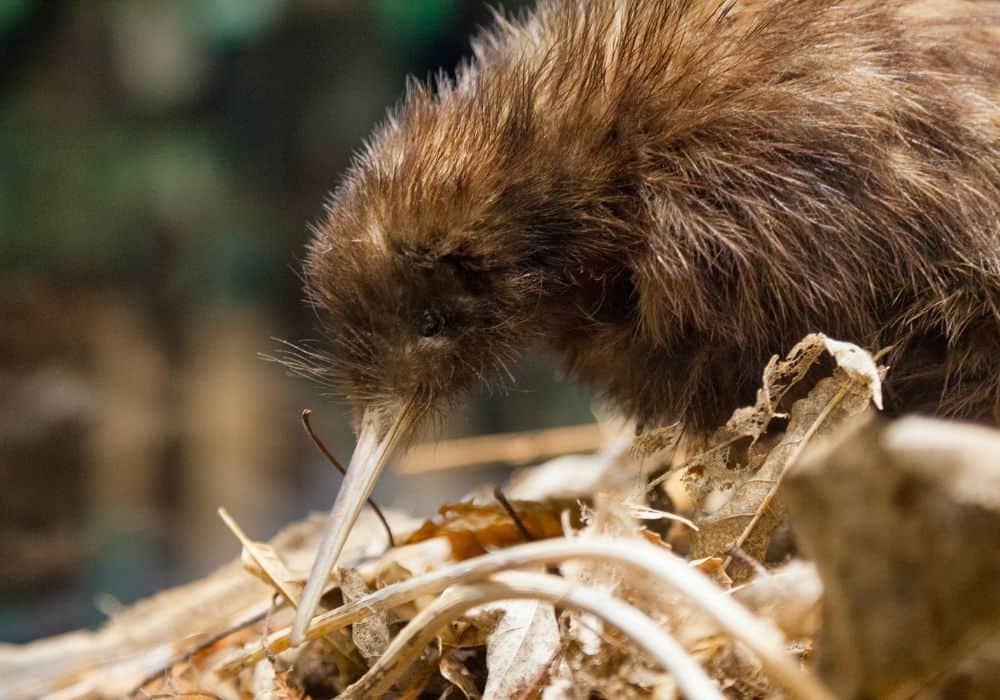How on earth did these tiny, fluffy balls of greasy-looking brown feathers, with long, ant-eater like beaks and beady eyes, become the national animal of New Zealand? How did they come to represent emotions like sadness, family loyalty and vulnerability?
In this ultimate guide to the kiwi bird of the Māori people, we’ll take a look at the bird’s appearance, behavior and history in an attempt to answer the symbolism attached to them, both by Māori and modern international spiritualists.
What are Kiwis?
Kiwis are a species of flightless bird unique to New Zealand, and a striking example of the isolated diversity and evolution of NZ animal species.
They are ratites – members of a group of large, long-legged and long-necked flightless birds which includes the ostrich, emus, rheas and cassowaries. Kiwis, however, are the exception, being small and squat.
The closest relative to the kiwi is, quite surprisingly, the extinct elephant bird of Madagascar, which weighed in around 730 kg (1,600 lb) and was up to 3m (9.8 ft) tall! Before the introduction of predators to New Zealand by foreigners, kiwis in the wild could live up to 50, 60, or sometimes even 70 years old!
Kiwi Appearance
Kiwis are remarkable looking birds. In my opinion, they look rather more like a field mouse with a beak and big belly, and almost exactly like echidnas. They are about the size of a chicken, an adult kiwi weighing on average just 2.8 kg (6.2 lb) and standing over average at just 40cm (16 inches) tall.
The kiwi is a flightless bird, like the ostrich or emu, with vestigial wings (meaning wings which no longer have any purpose) so small that they appear to have none at all. On top of thick, sturdy and scaly legs is a rotund body and tiny head with very small eyes (adapted for nocturnal activity) and a very long slender bill.
There are five extant species of kiwi living on New Zealand (and surrounding islands):
- Okarito kiwi
- Southern brown kiwi
- North Island brown kiwi
- Great spotted kiwi
- Little spotted kiwi
Each different species looks like the last, with the exception of size and differences in coloring, with feathers ranging between mixtures of red, black, gray and black.
Kiwi Habitat & Behavior
Kiwis live on the ground, in amongst the forest floors of New Zealand’s primal landscapes. They have a particular fondness for beech forests and woodlands of podocarp, though unfortunately are being pushed out of these by deforestation and human expansion.
They are also naturally diggers, choosing to nest in underground burrows which they dig out themselves. In these burrows, they lay eggs almost 1/5 of their own size. From kiwi eggs, their offspring are born fully-feathered and leave the nest after just 5 days to hunt and forage on their own, never once being fed by their own parents.
Kiwis have poor eyesight as are nocturnal, but very keen senses of smell (highly unusual in birds) and touch, which they use to seek out prey, even smelling worms below the ground and fruit up above them. The kiwi diet includes small invertebrates, seeds, grubs, and worms, as well (sometimes) as fruit, small crayfish, eels and other amphibians.
The peculiar anatomy of the kiwi (which also includes marrow inside the bones, rather than hollow bones for flight), combined with their behavior as burrowing, smelling, ground-dwelling flightless birds, has led many biologists to surmise that in the absence of any native New Zealand mammals, the kiwi took on a more mammalian role.
Kiwi Symbolism
Ancient, odd, resilient yet vulnerable, the kiwi has come to symbolise a lot for the people of New Zealand. They are found in the myths and folklore of the Māori time and again, and ‘kiwis’ even became the unofficial name for New Zealand soldiers in WWI. Now it’s time to learn all about kiwi symbolism.
The national symbol of New Zealand
Some countries have a national beast and a national bird, whilst others choose mythical creatures as their representatives on the international stage. But New Zealand? They have just one national animal, and it’s the kiwi. To New Zealanders, the kiwi symbolises the unique nature of their country.
Untouched by human feet until around 750 years ago, when the Polynesian Māori peoples first landed on New Zealand’s shores, they found a land covered in dense, rich soil and forest, replete with a cornucopia of weird and wonderful wildlife.
Birds, insects and bats which had not evolved anywhere else in the world in the place of any mammals. The kiwi, with its peculiar night-time habits and flightless wings, must have particularly enthralled the Māori, because it soon began to feature in their mythologies.
Over time, this reverence for the tiny bird fed into public consciousness, until – in the 19th and early-20th centuries – the kiwi began to feature on postage stamps, regimental badges, and in rugby cartoons. From amongst other popular symbols including the fern and a lion club, the kiwi was eventually chosen as New Zealand’s rightful national symbol.
Today, the kiwi is a reminder to New Zealanders of the importance of nature to them and their country.
A worldwide symbol of the New Zealand people
When the First World War began in Europe in 1914, the British Empire was at its height. Calling on reserve forces from as far afield as the Caribbean, India, Canada and Australia, Britain sent millions of foreign men and boys to their deaths in the name of wealth and influence.
This tragic story, however, resulted in one particularly strange outcome. With the kiwi as a symbol sewn into their regimental uniforms, many of the New Zealand soldiers fighting on the fields of Europe became known to their international comrades as ‘kiwis’.
Soon, this came to be a general, affable nickname given to anyone (not just soldiers) hailing from New Zealand. In essence, the kiwi – that small but curious, unique and otherworldly bird – came to symbolise all of the people of its country.
The Kiwi in Māori mythology and folklore
Māori speak of the kiwi with reverence and respect. In their mythologies, the kiwi (a name given to the bird either for its call, or because it resembled a ‘kiwi’ from the Polynesian homelands) is a selfless bird who gave up the power of flight in order to protect the forests.
As the story goes, one day Tanemahuta, the god of the forests, saw that his children (the trees) were being destroyed by an infestation of insects. Tanemahuta turned to the god of birds, Tanehokahoka, for help.
Tanehokahoka went among the birds, asking the Tui, the Pukeko (swamphen) and the Pipiwharauroa (cuckoo), asking each in turn to help by coming down to the forest floor to eat the insects. Yet, not one of the birds Tanehokahoka asked would give up the power of flight or the sunlight of the canopy.
In the end, it was the kiwi who saved the day, giving up both its wings and its beautiful colour to live a drab, simple, ascetic life on the forest floor. The kiwi’s sacrifice was never forgotten, and it remains the most beloved bird of the Māori to this day.
In Māori ceremony, a kiwi feather cloak – called a Kahu kiwi – was reserved for use only by people of the highest rank.
A Symbol of Motherhood
New Zealand’s kiwi lays just one egg come nesting season, and egg which – as we’ve discussed – is roughly one-fifth the size of her. If this were the same for human mothers, it would be equivalent to them giving birth to children already the size of a walking toddler. As such, it’s unsurprising that the kiwi is often seen as a symbol of motherhood, and the struggles of labour.
A Symbol of Love
It’s pretty rare in nature to come across animals which mate for life, but in the bird kingdom it seems to be a little more common than for other animal groups. The kiwi is another such bird, who chooses a mate and stays with that mate for life (in other words, in a monogamous relationship). Whilst monogamy is but one form of valid and worthwhile love, it remains in today’s society an admirable form. The kiwi’s monogamous lifestyle is symbolic of the endurance of love between partners.
A Symbol of Worldwide Conservation Efforts
Sadly, one of the most prevalent kiwi meanings is attached to one of the saddest facts about them. Many, many animals have been pushed into extinction, or at least to the verge of it, by we humans. And yet, most animals made extinct have not also been symbols of an entire modern nation.
The kiwi has seen its numbers decline from around 12,000,000 before colonisation to just 68,000 today. This stark drop in numbers, combined with the kiwi’s status as a symbol of New Zealand, is a symbol for the struggles of all the world’s wildlife against the encroachment of people.
Today, the Māori play a major role in protecting the kiwi, and controlling populations of predators like cats, dogs, stoats and eagles.
Conclusion
Kiwis are most curious animals – half bird, half mammal (it would seem) – emblematic of the struggle of the Māori against colonialism, and a reminder to New Zealanders far and wide of who they are, where they came from, and how unique the natural splendour of their country truly is.
